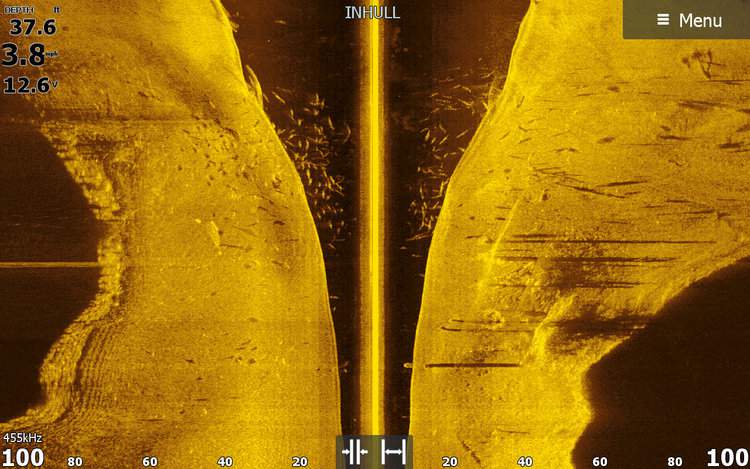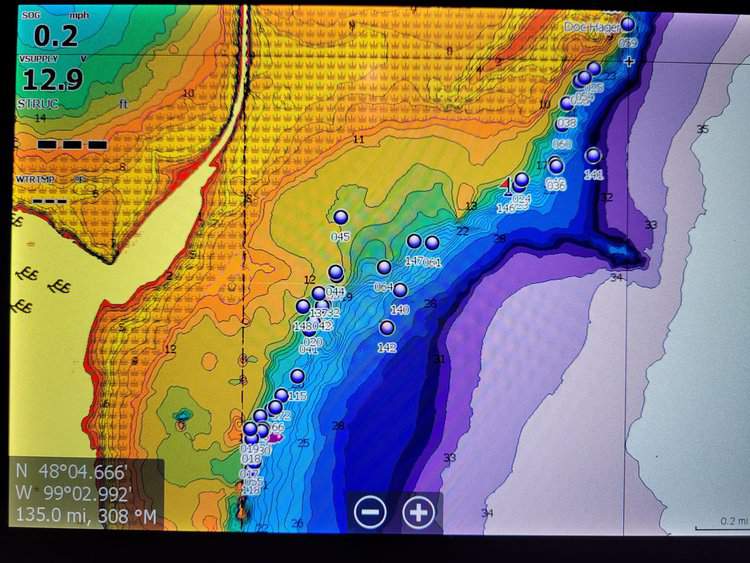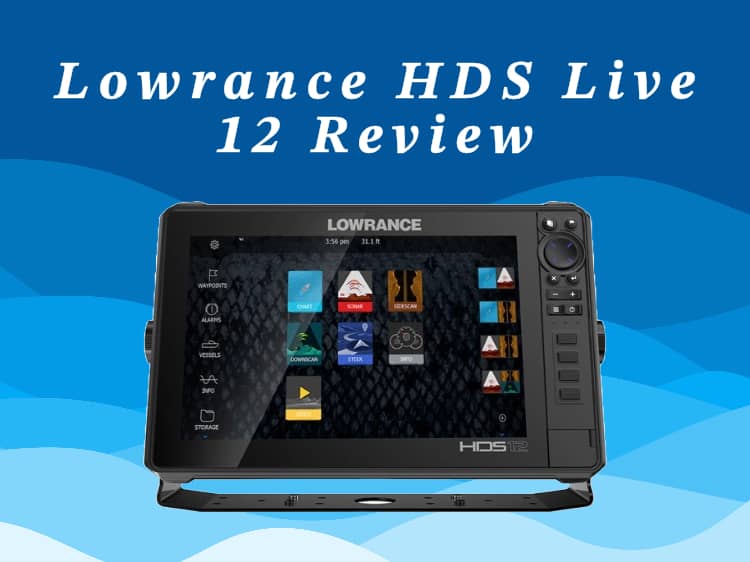The Lowrance HDS Live 12 is a high-end fish finder chartplotter combo. It is designed for serious anglers seeking advanced technology and features. As part of the HDS Live series, this model boasts a 12-inch display, offering a larger screen size compared to its 7 and 9-inch counterparts. This larger display provides enhanced clarity and visibility, making it easier to view detailed charts, sonar readings, and other crucial data.
The fish finder is equipped with state-of-the-art sonar technology, including CHIRP Sonar, SideScan, and DownScan imaging, providing anglers with a comprehensive view of the underwater environment. This helps in identifying fish targets, structures, and bottom contours with remarkable precision. Additionally, the HDS Live 12 supports Active Target real-time sonar, which gives anglers a real-time view of fish movements and reactions to their lures.
Network and connectivity features are a strong point of the HDS Live 12. It offers wireless and Bluetooth connectivity, allowing anglers to connect their smartphones and other devices for data sharing, map updates, and even remote control of certain functions. The dual microSD card slots offer expanded storage and easy data management.
Overall, the Lowrance HDS Live 12 is tailored for anglers who demand top-notch technology and features. Its large display, advanced sonar capabilities, and robust connectivity options make it a versatile and powerful tool for enhancing fishing experiences, although it’s high-end features and price point may be more suited to experienced or professional users rather than beginners.
Key Specifications:
| Specification | Detail |
| Display Size | 12 inches |
| Resolution | 1280 x 800 |
| Sonar Technology | CHIRP Sonar, SideScan, DownScan |
| Transducer | Active Imaging 3-in-1 |
| Frequencies | 83/200/455/800 kHz |
| Depth Range | Traditional: 1000 ft (305 m), DownScan: 300 ft (91 m), SideScan: 600 ft (183 m) side-to-side |
| GPS | Built-in |
| Mapping | Preloaded C-MAP |
| Waterproof Rating | IPX7 |
| Price (MSRP) | $2749 USD |
Display Quality
The display quality of the Lowrance HDS Live 12 is excellent, combining high resolution, brightness, and responsive touchscreen technology to provide a top-tier visual experience for anglers.

It features a SolarMAX HD screen, renowned for its exceptional clarity and brightness. This high-resolution display offers wide viewing angles, making it easier to see the screen from different positions on the boat. The screen’s performance in various lighting conditions, including bright sunlight, is a notable strength, ensuring that the display remains visible and legible even in challenging outdoor environments.
Additionally, the touchscreen functionality of the HDS Live 12 is responsive and intuitive, enhancing the overall user experience. This responsiveness, coupled with the high-definition display, ensures that anglers can easily access and interpret data, which is crucial for making informed decisions while fishing.
Sonar Performance
The sonar capabilities of the Lowrance HDS Live series are highly acclaimed, and considered among the best in the market for fish finders and chartplotters. The HDS Live offers a range of advanced sonar technologies, including:
- CHIRP Sonar: Provides detailed, high-resolution imaging of fish and structure beneath the boat, enhancing target separation and clarity.
- SideScan and DownScan Imaging: These features give a more comprehensive view of the underwater environment, allowing anglers to see structure and fish to the sides and directly beneath the boat.
- ActiveTarget: A standout feature, ActiveTarget offers real-time views of fish movements and how they react to bait or lures. This technology is especially useful for precision fishing and understanding fish behavior.
- StructureScan 3D: Some models include StructureScan 3D technology, which provides three-dimensional views of underwater terrain and fish-holding structures.
The combination of these sonar technologies makes the Lowrance HDS Live highly effective in various fishing conditions, providing anglers with detailed and actionable information. The clarity, depth range, and accuracy of its sonar readings are often cited as top reasons for its popularity among both recreational and professional anglers.
SideScan
The below screenshot of the HDS Live 12’s SideScan sonar presents a detailed view that showcases the device’s capabilities well. The SideScan has excellent resolution and clarity, as evidenced by the distinct outlines of underwater structures and the clear separation between individual fish and groups of fish. The screen also displays useful information such as depth, boat speed, and battery voltage, which are clear and easy to read.

The sonar image shows a well-defined bottom structure and the water column, along with fish arches, which are crucial for anglers to identify target species and habitats. The quality of the SideScan sonar on the HDS Live 12 is top-notch, providing anglers with a near-photographic view of the underwater environment on either side of the boat, extending to a significant range.
Based on this image, the SideScan sonar of the HDS Live 12 would rate highly on both detail and functionality, reflecting Lowrance’s commitment to integrating advanced sonar technology in their side imaging fish finders. The device is capable of delivering the kind of high-quality imagery that can greatly enhance the fishing experience and success.
DownScan
The below image from the HDS Live 12’s DownScan sonar reveals a high level of detail and definition. The DownScan image shows a clear separation between the bottom, the structure, and the individual fish, with fish appearing as distinct shapes against the solid background of the water column and bottom.

The clarity of the underwater features, including the vegetation and submerged trees, is impressive. You can see individual branches and their orientation, which provides invaluable information for habitat mapping and locating fish.
The DownScan sonar quality of the HDS Live 12 would be rated as excellent, demonstrating the capability of providing anglers with a clear and detailed view of the underwater environment, essential for effective fishing and navigation.
ActiveTarget
ActiveTarget is highly praised for its capability to provide real-time sonar images. This allows anglers to see how fish are positioned in structure and how they respond to bait and lures, in real-time. The live view sonar can be switched between Forward, Down, and Scout modes, offering versatility in tracking fish movement around the boat. This real-time feedback can be invaluable for anglers in making immediate tactical decisions. The high-resolution images and detail offered by ActiveTarget are considered top-tier in the industry, making it an excellent addition for HDS Live 12 to upgrade the fish-finding capabilities.

To add the ActiveTarget sonar to an HDS Live 12 unit, you would need to purchase the Active Target Module, which is designed to work with several Lowrance units, including the HDS Live series. The process involves connecting the module to your HDS Live 12 unit via an Ethernet cable. Since the HDS Live 12 has two Ethernet ports, it simplifies the integration process, allowing for a direct connection without the need for additional network expansion hubs.
GPS and Mapping
The Lowrance HDS Live 12 comes equipped with an array of GPS and mapping features that are designed to enhance the navigation and fishing experience.

Basic Maps:
The unit includes pre-loaded C-MAP maps stored in the internal memory of the device. These base maps provide a fundamental level of detail, showing contours and navigational aids. They are suitable for many users who require standard mapping information and are not looking for highly detailed or specialized charts.
Upgraded Options:
For users requiring more detailed information, there are several upgraded mapping options available for the HDS Live 12. These include:
- C-MAP Genesis Live: Allows users to create or modify maps of their local fishing spots in real-time. This feature is excellent for mapping uncharted waters or for getting updated contours of familiar areas.
- C-MAP Max-N+: Offers high-resolution mapping and detail, including custom depth shading, high-resolution bathymetry, and more.
- Navionics: Provides detailed charts with updates on marine parks, safety depth contours, marine reserves, and more. Navionics also offers a subscription service with regular updates.
Benefits:
Upgraded maps are beneficial because they offer anglers and boaters increased detail and updated information, which can be crucial for navigating tricky waters, locating fishing hotspots, or planning a day out on the water. For example, more detailed contour lines can help in identifying underwater structures where fish may be hiding, and updated navigational aids can assist in safe boating.
To update these maps or the unit’s software, you would use an SD card. Updates typically involve registering your map card, and for some services, purchasing a subscription may be necessary after the initial period. These updates ensure that your device has the latest information, improving the accuracy and reliability of your navigational aids and maps.
HDS Live Transducer
HDS Live 12 comes with the Lowrance Active Imaging 3-in-1 transducer which provides clear and comprehensive sonar imaging. This transducer offers CHIRP sonar, SideScan, and DownScan imaging.
Mounting Options
The Lowrance HDS Live Active Imaging 3-in-1 transducer can be mounted using several methods, depending on the type of boat and the desired usage. Here are the common mounting options:
- Transom Mount: This is the most common and easiest way to mount the transducer. The transducer is attached to the transom (the flat surface at the back of the boat) at or below the water line using a mounting bracket. It’s adjustable, so you can set the proper angle for optimal sonar returns.
- Trolling Motor Mount: The transducer can be attached to the shaft of a trolling motor using a specialized bracket or a hose clamp setup. This is a popular option for smaller boats or when wanting to see the sonar return from the front of the boat.
- Jackplate Mount: For high-speed performance boats, the transducer can be mounted on the side of a jackplate to keep it in clean water and prevent cavitation and aeration around the transducer at high speeds.
- Thru-Hull Mount: This is a more permanent solution where the transducer is mounted inside the hull of the boat, making direct contact with the water. This type of installation is complex and typically requires professional installation.
Price and Deals
The MSRP of $2749 for the Lowrance HDS Live 12 reflects its position as a premium fish finder/chartplotter in the market, equipped with a range of advanced features including high-definition sonar, real-time mapping, and a high-quality display. Whether it is worth the price depends on the individual needs and budget of the angler or boater. For serious enthusiasts who require detailed sonar imaging, extensive mapping capabilities, and high-end features for competitive use or deep-sea fishing, the HDS Live 12 can be seen as a valuable investment.
However, there are ways to find the HDS Live 12 at more competitive prices. For instance, Lowrance’s own website occasionally offers promotional deals where you can save up to $1200 off the HDS Live series. Significant discounts are often available during specific sales events, such as Black Friday.
Additionally, some retailers offer bundle deals that include additional equipment, which may offer further savings. Always ensure that the unit includes the necessary components for your needs, such as transducers or mapping software, as these can impact the overall value of the package.
FAQs
What are the mouting options for the HDS Live 12 display unit?
The Lowrance HDS Live 12 display unit offers several mounting options to accommodate various boat layouts and user preferences:
- Gimbal Mount: This is the standard mounting option that comes with the unit. It allows for tilting and swiveling of the display for optimal viewing angles. It’s commonly used on boat dashboards or other flat surfaces.
- Flush Mount: For a cleaner and more integrated look, the HDS Live 12 can be flush-mounted into the console of the boat. This requires a cutout in the dash and is a more permanent solution.
- RAM Mounts: These aftermarket mounts offer flexible positioning and are known for their durability and ease of adjustment. They are ideal for users who want to easily remove the display unit or adjust it frequently.
- In-Dash Mounts: Some boats have designated electronics boxes or spaces in the dash where the unit can be mounted for a built-in appearance.
- Rail/Bar Mounts: For smaller boats or if you prefer to mount the unit on a rail or bar, there are mounting systems designed for this purpose, which can be especially useful on boats like center consoles or RIBs.
How to use Lowrance HDS Live?
Using the Lowrance HDS Live involves navigating through various settings and features to optimize the device for your specific needs. Here’s a brief overview of how to use it:
- Initial Setup: When you first turn on your HDS Live unit, you can explore the different functionalities it offers through the home screen icons such as Chart, Sonar, Side Scan, Down Scan, and Radar. If you have additional modules like a 3D module or autopilot, you’ll find these here as well.
- Accessing Settings: Press the gear icon to enter the System Settings. Here, you’ll find a range of options, including system preferences, navigation, sonar, and wireless settings.
- Chart Settings: In the charts section, you can enable features like heading extension, which helps you see your travel direction, and waypoints/route display.
- Sonar Settings: This is crucial for setting up your transducer. You’ll need to ensure that the correct channel is active depending on the type of transducer you’re using (e.g., CH1 for in-hull or puck style, CH2 for structure scan transducers). You can also select the transducer type to match the model you have installed.
- Network Configuration: If you have multiple units, you can configure them to share data. This includes setting up which unit is the source for depth and temperature data. You can also connect your device to other units or to the internet for updates and additional functionalities.
- Wireless Connectivity: The wireless settings allow you to connect your unit to Wi-Fi and Bluetooth devices. This is useful for updating the software and for connecting to compatible devices like smartphones.
- Customizing Sonar Views: You can adjust sonar frequencies for better range or detail and change color palettes to enhance visibility under different conditions. Playing with these settings helps you get the best images possible.
- Data Sources and Network: For advanced setups, you can determine the data sources for various readings, which is important when running multiple units to ensure you’re getting the correct data from the intended transducer.
What is the best battery for Lowrance HDS Live 12?
The HDS Live 12 has a power consumption of 37.3 W, which translates to an amperage draw of approximately 2.7 A at 13.8 V DC. The battery must consistently deliver within the range of 10 – 17 V DC, with the optimal operating voltage being 13.8 V DC.
To determine the battery capacity, you need to calculate the total amperage draw of all your devices and consider how long you will be using them between charges. A common way to estimate is to use amp-hours (Ah). For instance, if you plan to run the HDS Live 12 for 8 hours, you would need a battery with a capacity of at least 21.6 Ah (2.7 A x 8 h), but it’s always good to have a larger capacity for extended use and to account for battery aging.
Deep-cycle marine batteries are typically recommended for fish finders and other electronics on boats due to their ability to be discharged and recharged many times. Within this category, you have options like Lead-Acid, Gel, AGM (Absorbed Glass Mat), and Lithium-Ion batteries.
For the best battery, you might consider a 12V AGM deep-cycle marine battery with a capacity of at least 50 Ah to ensure ample power for longer trips and to account for additional devices you may use. Always ensure your charging system on the boat is compatible with the battery type you choose and follow the manufacturer’s recommendations for charging and maintenance.

